RELG 402 - World's Living Religions
Sikhs
| The Ten Gurus | Beliefs | The Guru Granth Sahib |
| Gurdwara | The Golden Temple | Rites of Passage |
| The Five Ks | Life style | Time Line |
Images in the text are linked to larger photos - click on them to see the larger pictures.
Hover the mouse over the images to see their captions.
 Sikhism was founded in the 15th century by Guru Nanak, in the Punjab (northern India), and is now ranked as the world's 5th largest religion.
Sikhism was founded in the 15th century by Guru Nanak, in the Punjab (northern India), and is now ranked as the world's 5th largest religion.
Sikhs strive for devotion and remembrance of God at all times, truthful living, the equality of mankind, and renounce superstitions and blind rituals. Sikhism is open to all through the teachings of its 10 Gurus enshrined in the Sikh Holy Book and the Living Guru, Sri Guru Granth Sahib.
Guru Nanak grew up in a region where there were both Hindus and Moslems. It is said that when Guru Nanak was bathing in a river he had a sudden insight that there was just One Divine Being, and that all men and women should unite in worship and service.
Guru Nanak eventually settled on the banks of the river Ravi. Here, the first Sikh community grew around him as people came to hear the Guru’s words and practice the values of equality, civic action, and inclusivity which he taught.
In contrast to the Hindus and Buddhists, he taught that monastic practices should be abandoned, and that people should live as family and follow the ordinary occupations and civic duties of life. He also condemned the Hindu and Moslem practices of keeping women subjugated and veiled, and taught that society was to be egalitarian and just. The community's pattern of seva (voluntary service), langar (cooking and eating together irrespective of caste, sex, or status), and sangat (congregation) was the basis for the growing Sikh community.
There were nine Gurus after Guru Nanak (see Timeline below)
The Tenth Guru, Gobind Singh, established Sikhism as the "Community of the Pure" - the Khalsa, and performed the first Amrit Ceremony in 1699. He called his followers to assemble on the day of Vaisakhi (the harvest festival), and prepared a drink by stirring water and sugar in an iron bowl with his two-edged sword while singing sacred hymns. Guru Gobind Singh stood in front of a small tent and addressed the crowd, reminding them of the persecution of Sikhs, and of the martyrdoms of Guru Arjam and Guru Teg Bahadur. Then he unsheathed his sword and challenged them to "give their heads to the Guru"
At first no-one came forward. He challenged them three times, and on the third time a man called Daya Ram stood forward and offered to die. Guru Gobind Singh led him into the tent, then came out with his sword covered in blood, and asked for anyone else to come forward. Another man did so and was led into the tent. A total of five men took his challenge and entered the tent. Then Guru Gobind Singh led them out to the assembled crowd and proclaimed that they were the Five Beloved ones, the Panj Pyare
 These five men drank the Amrit, and became the first members of the Khalsa family. They were from different castes, families, and professions, but they all became part of the one Khalsa family as they drank from the one bowl. They undertook to fight for equality, justice and liberty, against oppression and prejudice.
These five men drank the Amrit, and became the first members of the Khalsa family. They were from different castes, families, and professions, but they all became part of the one Khalsa family as they drank from the one bowl. They undertook to fight for equality, justice and liberty, against oppression and prejudice.
Then Guru Gobind Singh knelt and asked the five Panj Pyare to initiate him into the Khalsa - this is when he took the name Singh.
The day of Baisakh became one of the holiest days in the Sikh calendar.
In the days that followed, it is estimated that about 80,000 Sikhs were initiated into the Khalsa as "saint-soldiers"
Guru Gobind Singh did away with the system of family surnames, and gave his followers new titles - men were named Singh (lion), and women were Kaur (princess).
Shortly before his death in 1708 Guru Gobind Singh declared that the Sikh sacred text would become his successor as The Living Guru - The Guru Granth Sahib.
Guru Gobind Singh summed up the life of a Sikh when he told his followers
From now on, you have become casteless.
No ritual, either Hindu or Muslim, will you perform, nor will you believe in superstition of any kind, but only in one God who is the master and protector of all, the only creator and destroyer.
In your new order, the lowest will rank with the highest and each will be to the other a brother.
No pilgrimages for you any more, nor austerities, but the pure life of the household, which you should be ready to sacrifice at the call of Dharma.
Women shall be equal of men in every way. No purdah (veil) for them anymore, nor the burning alive of a widow on the pyre of her spouse (sati).
Beliefs
Sikhs believe in One Divine Reality which permeates every creature and yet transcends space and time. The One does not have gender, but is named Truth, and is the Creator of all beings. Sikhs believe that everything that happens is Hukam – the will of Waheguru (God). They believe that there is a divine spark which is part of Waheguru in each person and this spark or soul is taken back to join Waheguru when a person is finally released from the cycle of reincarnation. Freedom from the cycle is called mukti.
Sikhs believe that God :
- Cannot be described and is neither male nor female
- Is eternal truth, timeless, beyond the cycle of birth and death, and self-existent
- Is both sargun (immanent – everywhere and in everything) and nirgun (transcendent – above and beyond creation)
- Created the world for people to use and enjoy
- Created people, and made them know the difference between right and wrong
- Is present in everyone's soul but can only be seen by those whom he blesses
- Is personal and available to everyone
- Is the only one to be worshipped; no images of God are to be worshipped
- Is made known by the grace of the Guru
There are many Sikh names for God, yet each is inadequate to express the reality of Waheguru (God) : "Sat Nam" (Eternal Reality); "Akal Purakh" (Eternal One); "Waheguru" (Wonderful Lord)
Sikhs believe that there is only one God but that this is the God of all religions. No single religion can claim to be the only true way to Waheguru, and different religions are just different ways towards Waheguru. According to the Guru Granth Sahib 103
You are Father, Mother, Friend, Brother, with you as support everywhere, what fear can I have?
Sikhs believe in reincarnation. This means that a person’s soul may be reborn many times as a human or an animal. Therefore, for Sikhs, death is not the end. The Sikh sacred text, the Guru Granth Sahib, says that the body is just clothing for the soul and is discarded at death.
Sikhs believe that there are 8,400,000 forms of life and that souls may have to travel through a number of these before they can reach Waheguru. When something dies its soul is reborn. Only humans know the difference between right and wrong, so it is only when the soul is in a human being that there is a chance of the cycle being broken.
Sikhs believe in karma. There are five attitudes harmful to humans - lust (kam), anger (karodh), greed (lobh), attachment to things (moh), and pride (hankar). They lead to manmukh - being self-centered, instead of Gurmukh (God-centered), and focus on egotism - "I-Myself" and separate humans from their Divine core, and cause maya - illusion - looking at the world and ignoring God. They also split humans from the people around them - thus causing inequalities and injustice.
One must guard against them by reading and singing the sacred texts, which will bring the person back into harmony with the Divine. One must live a life of sewa - selfless service to others.
Sikhs believe that suffering is not inflicted directly by God but is permitted by God as a test of courage and faith.
The Guru Granth Sahib
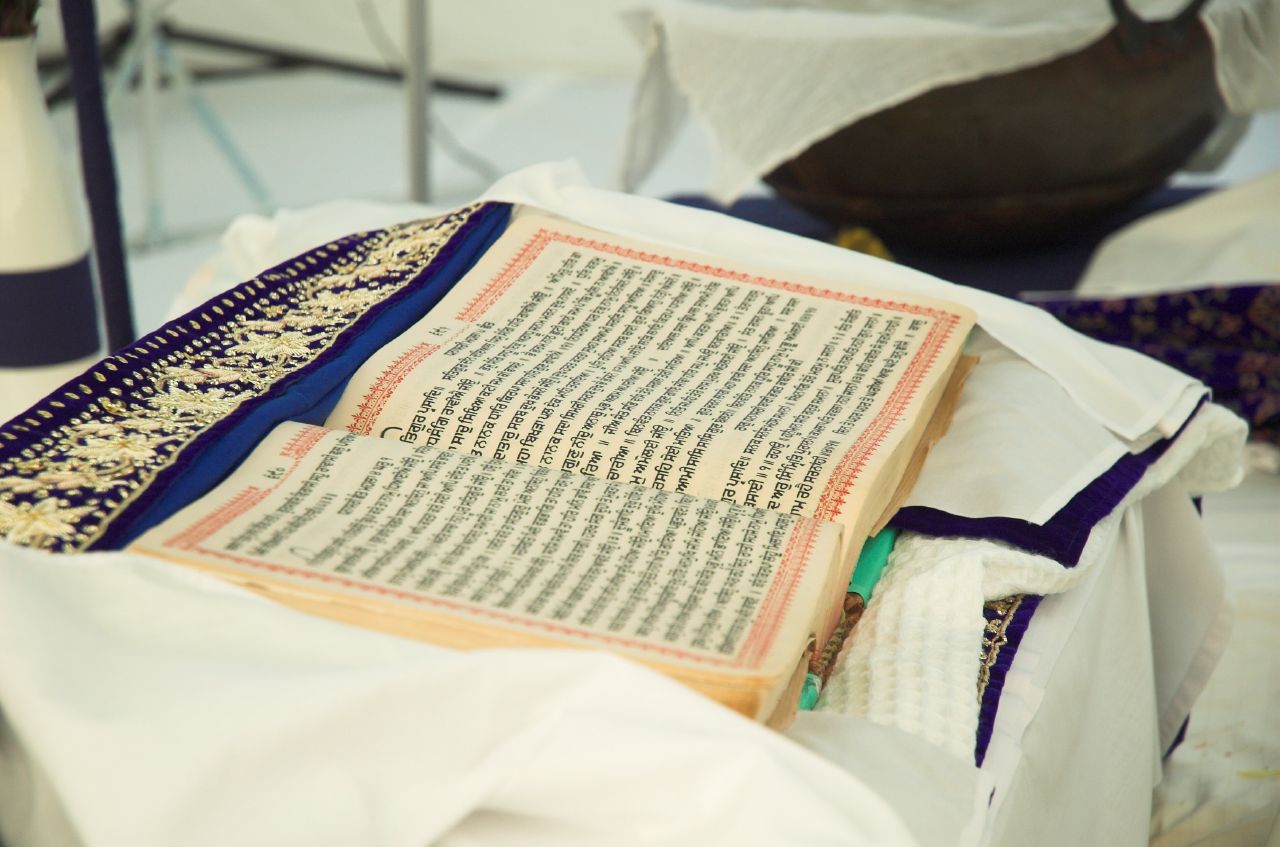 The Sikh sacred text is the Guru Granth Sahib. "Guru" means teacher, and "sahib" is an honorary title equivalent to Sir. The Guru Granth Sahib is a collection of hymns composed by Guru Nanak, and also sayings of Hindu and Moslem holy men. It was compiled in 1604 by the Fifth Guru, Guru Arjan.
The Sikh sacred text is the Guru Granth Sahib. "Guru" means teacher, and "sahib" is an honorary title equivalent to Sir. The Guru Granth Sahib is a collection of hymns composed by Guru Nanak, and also sayings of Hindu and Moslem holy men. It was compiled in 1604 by the Fifth Guru, Guru Arjan.
The Guru Granth Sahib is regarded as a living guru - the last of the Sikh Gurus. It is written in the Gurmukhī script, in the dialects of the people of India, rather than the Sanskrit or Arabic of Hindu and Moslem scriptures, so as to be understood by all.
 It is at the center of Sikh worship and is treated as a person - it is draped in silks and brocades, and sits on a cushion or carpet. A canopy hangs over it, and an attendant waves a fly-whisk over it - these were symbols of royalty in India. In the Gurdwara it is put to bed in its own room every evening.
It is at the center of Sikh worship and is treated as a person - it is draped in silks and brocades, and sits on a cushion or carpet. A canopy hangs over it, and an attendant waves a fly-whisk over it - these were symbols of royalty in India. In the Gurdwara it is put to bed in its own room every evening.
 At the beginning of the day the Granthi (keeper of the Guru Granth Sahib), and any other Sikhs present, form a procession to carry the Guru Granth Sahib to its position on the Manji Sahib (small platform on which the Guru Granth Sahib is placed) in the Diwan hall (the room where worship takes place) of the Gurdwara.
At the beginning of the day the Granthi (keeper of the Guru Granth Sahib), and any other Sikhs present, form a procession to carry the Guru Granth Sahib to its position on the Manji Sahib (small platform on which the Guru Granth Sahib is placed) in the Diwan hall (the room where worship takes place) of the Gurdwara.
Sikhs bow to it, sit near it, and may open it at random for a personal message for the day.
Sikhs show respect for the Guru Granth Sahib as if they were showing respect to a living teacher: they bow to the Guru Granth Sahib, cover their heads and remove their shoes. The Guru Granth Sahib is never placed on the ground and Sikhs never turn their back on it.
Not one word may be changed in it.
Most Sikhs do not own a copy of the Guru Granth Sahib because of the difficulty of showing it the proper respect. Most Sikh families have a copy of the Dasam Granth (poetry written by Guru Gobind Singh and not included in the Guru Granth Sahib) or the sacred Nit nem (a prayer book) at home.
The Mool Mantar :
Mool Mantar means "basic teaching" and is found at the beginning of every section of the Guru Granth Sahib.
Sikhs repeat it each day during their morning prayers.
Ik Onkar There is only one God
Sat Nam Eternal truth is His name
Karta Purakh He is the creator
Nir Bhau He is without fear
Nir Vair He is without hate
Akal Murat Immortal, without form
Ajuni Beyond birth and death
Saibhang He is the enlightener
Gur Prasaad He can be reached through the mercy and grace of the true Guru
The Gurdwara
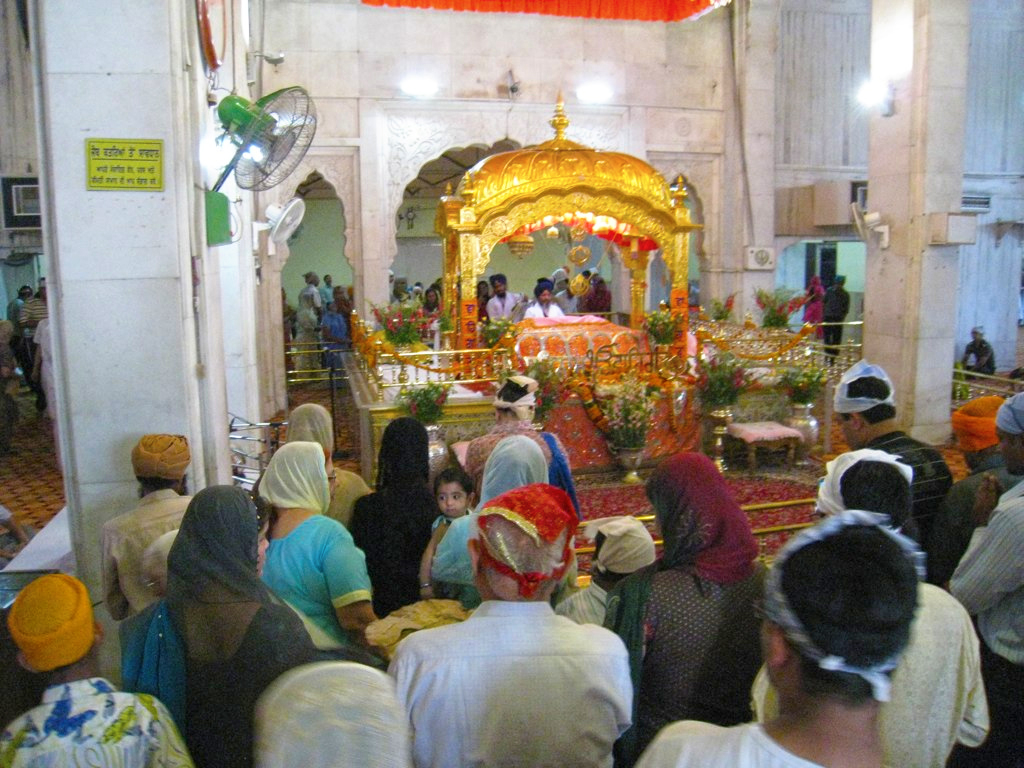 The Sikhs' religious building is called a Gurdwara, dwara means door, and a Gurdwara is a "Door to the Guru". It is a place for Sikhs to meet for worship and for communal activities such as cooking and eating together. Gurdwaras outside India are organized and managed by the local community of Sikhs, who elect an executive board and trustees to oversee the running of the Gurdwara. Members of the community volunteer their time and talents to serve at the Gurdwara. The Sikh Ethical Code is used as a guide for the affairs of the Gurdwara, which include not only religious matters but also social and community affairs.
The Sikhs' religious building is called a Gurdwara, dwara means door, and a Gurdwara is a "Door to the Guru". It is a place for Sikhs to meet for worship and for communal activities such as cooking and eating together. Gurdwaras outside India are organized and managed by the local community of Sikhs, who elect an executive board and trustees to oversee the running of the Gurdwara. Members of the community volunteer their time and talents to serve at the Gurdwara. The Sikh Ethical Code is used as a guide for the affairs of the Gurdwara, which include not only religious matters but also social and community affairs.
A Gurdwara has a room for worship, called a Darbar Sahib, where the Sikhs gather for worship. There are no statues, religious pictures or other idols. There are no bells, incense, or candles.
The congregation sits on the floor while someone reads a passage out of the Guru Granth Sahib.

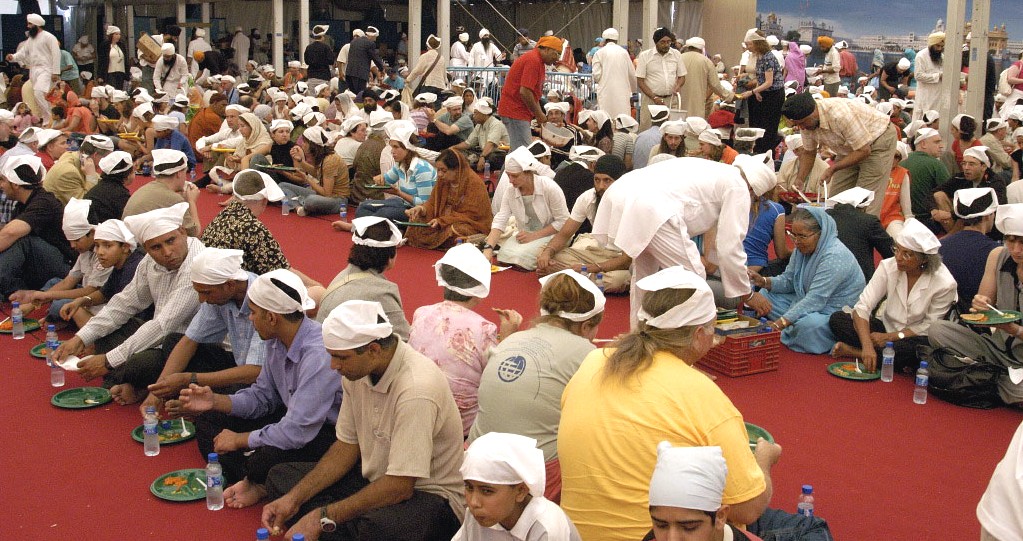 It also has a Langar - the kitchen and eating area for the community. It may have additional areas such as classrooms, library, nursery, etc. A Gurdwara usually has flags outside it, including the Nishan Sahib, the Sikh triangular flag with the emblem of three crossed swords.
It also has a Langar - the kitchen and eating area for the community. It may have additional areas such as classrooms, library, nursery, etc. A Gurdwara usually has flags outside it, including the Nishan Sahib, the Sikh triangular flag with the emblem of three crossed swords.
Daily rituals are carried out morning and evening at a Gurdwara - hymns out of the Guru Granth Sahib are sung, and someone reads from the Guru Granth Sahib and gives a religious discourse.
Anyone, of any faith, can visit a Gurdwara and will be made welcome, and they are welcome to partake of the food that is served. Before going into a Gurdwara, one should remove ones shoes and wash ones feet if they are dirty; cover ones head (young children needn't bother). Don't go in drunk, or carrying alcohol, tobacco or drugs. On entering a Gurdwara, Sikhs will bow to the Guru Granth Sahib as the first thing they do, touching the floor with their forehead. They place an offering of food or money in front of the Guru Granth Sahib (this is used to run the Gurdwara and the free food kitchen). People who have no money or food to offer may offer flowers, or just some words of sincere thanks. After bowing to the Guru Granth Sahib a Sikh will greet the congregation with a ritual greeting in a low, quiet voice. Non-Sikh visitors should also bow and make an offering. Everyone sits on the floor - this is to be humble before the Guru Granth Sahib, and because it gives everyone a place of equal status to sit. Cushions and seats are not allowed. Most people sit cross-legged. One should not sit with the feet pointing at the Guru Granth Sahib. Men and women generally sit on separate sides of the hall. Anyone who walks round the Guru Granth Sahib or the Gurdwara must do so in a clockwise direction. Towards the end of a service, a sweetmeat that has been blessed, called karah prasad, is served. This should be taken and received in cupped hands as a gift of God.
Karah is made from flour and sugar moistened with ghee (melted butter).
In the Langar, only vegetarian food is served - not because Sikhs are vegetarians, but because they do not wish to offend members of other religions which do not permit certain foods.
 There is no priesthood or clerical hierarchy in Sikhism. Any Sikh can lead the prayers and readings at a service.
There is no priesthood or clerical hierarchy in Sikhism. Any Sikh can lead the prayers and readings at a service.
Each Gurdwara has a Granthi who organizes the daily services and reads from the Guru Granth Sahib. A Granthi is not a priest but is the custodian of the Guru Granth Sahib, and is trained to read the Gurmukhi language and to look after the Guru Granth Sahib.
Sikhs don't have a general official liturgy that must be used in a Gurdwara, although there are rules for particular ceremonies.
The Golden Temple
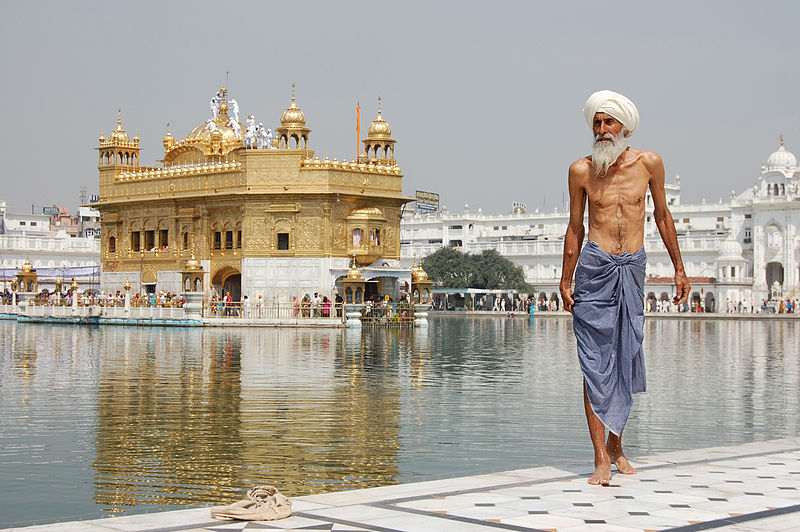 The Golden Temple at Amritsar is the most holy Sikh shrine. It is surrounded by a holy lake, with bridges across to it. It has four doors, one on each of its sides, to symbolize that it is open to all comers. It contains the original book of the Guru Granth Sahib. About 80,000 people visit the Golden Temple daily (many of them are not Sikhs) and eat the food which is provided freely by volunteers.
The Golden Temple at Amritsar is the most holy Sikh shrine. It is surrounded by a holy lake, with bridges across to it. It has four doors, one on each of its sides, to symbolize that it is open to all comers. It contains the original book of the Guru Granth Sahib. About 80,000 people visit the Golden Temple daily (many of them are not Sikhs) and eat the food which is provided freely by volunteers.
Rights of Passage
Sikhs celebrate four rites of passage through life :
- Naam Karan - the Naming Ceremony - as soon as it is born, the words of the Mool Mantra prayer are whispered into a baby's ears, and a drop of honey placed on the baby's tongue. As soon as possible the baby is taken to the Gurdwara, where the Guru Granth Sahib is opened at random and the Granthi (guardian of the Guru Granth Sahib) reads the passage. The family choose a name starting with the first letter of the passage. The congregation celebrates by eating sweet sticky karah parshad.
-
 Amrit Initiation is open to any adult who wishes to accept the Sikh code of conduct. The ceremony re-enacts the first Amrit ceremony by Guru Gobind Singh in 1699. The Amrit Ceremony is performed in a Gurdwara in the presence of 5 initiated Sikhs (commemorating the Panj Piyaras, the first Five Sikhs) as witnesses. The candidate(s) for initiation drink some of the amrit from the same bowl, and have it sprinkled on their eyes and hair. Amrit is a mixture of sugar and water that has been stirred with a double-edged sword.
Amrit Initiation is open to any adult who wishes to accept the Sikh code of conduct. The ceremony re-enacts the first Amrit ceremony by Guru Gobind Singh in 1699. The Amrit Ceremony is performed in a Gurdwara in the presence of 5 initiated Sikhs (commemorating the Panj Piyaras, the first Five Sikhs) as witnesses. The candidate(s) for initiation drink some of the amrit from the same bowl, and have it sprinkled on their eyes and hair. Amrit is a mixture of sugar and water that has been stirred with a double-edged sword.
They recite the Mool Mantra which declares the fundamentals of Sikhism. There are readings from the Guru Granth Sahib, and an explanation of rules of Sikhism. The ceremony ends with the eating of the ceremonial karah parshad. Parshad is a sweet tasting food which has been blessed. It is made from semolina, sugar and ghee.
The initiated Sikh takes the name of Singh (for a man) or Kaur (for a woman). They wear the Five Ks from then on. -
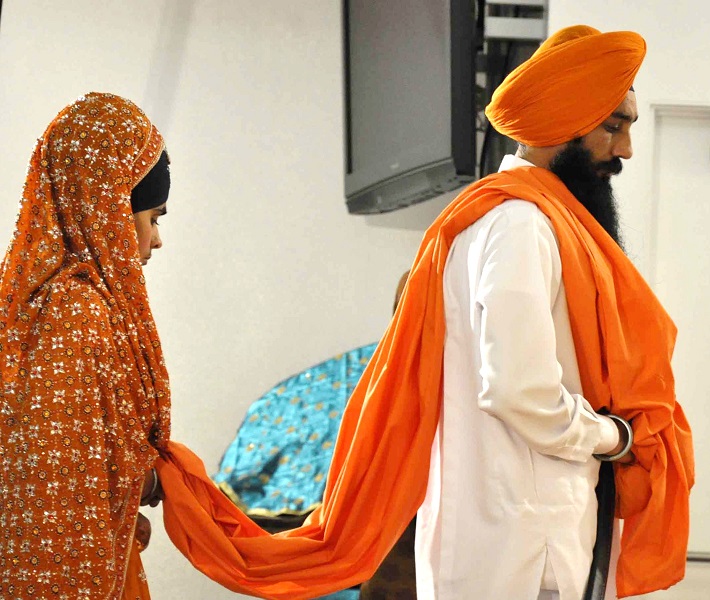 Anand Karaj, marriage - The bride and groom do not exchange any vows or exchange of rings, but they go to the Gurdwara and present themselves for a blessing. The Wedding Hymn is read out of the Guru Granth Sahib while they circle the Guru Granth Sahib four times. After each circle the bride and groom touch their foreheads to the ground together as a sign of their acceptance of each other, with the Guru Granth Sahib as the center of their lives and their witness and guide in marriage. Marriage is for life, and joins not only the bride and groom, but also their families into one extended family. Both partners must be Sikhs, and they are regarded as equal partners in a life-long union.
Anand Karaj, marriage - The bride and groom do not exchange any vows or exchange of rings, but they go to the Gurdwara and present themselves for a blessing. The Wedding Hymn is read out of the Guru Granth Sahib while they circle the Guru Granth Sahib four times. After each circle the bride and groom touch their foreheads to the ground together as a sign of their acceptance of each other, with the Guru Granth Sahib as the center of their lives and their witness and guide in marriage. Marriage is for life, and joins not only the bride and groom, but also their families into one extended family. Both partners must be Sikhs, and they are regarded as equal partners in a life-long union. - Antim Sanskar - at death - Sikhs cremate their dead. When someone seems about to die the family will come to the bedside and say Sukhmani (the Hymn of Peace). The dying person tries to reply Waheguru.
The body is washed and dressed in new Sikh clothing. The coffin is taken to the gurdwara and placed in front of the Guru Granth Sahib. It is then taken to the cremation grounds, prayers are said, and the funeral pyre is lit by the oldest son. As the coffin burns the Kirtan Sohila (the evening prayer) is said:
God has determined the time for my nuptials;
The ashes are collected and put into natural running water (a river). Afterwards, in the gurdwara, the Anand Sahib (prayer) is sung, and the Ardas (prayer) is said. The ceremony ends with karah parshad (offering of food blessed by the guru).
come pour the oil of joy at my door.
Bless me, my friends, that I find that sweet union,
dwelling as one with my Master and Lord.
All must receive their last call from the Master;
daily he summons those souls who must go.
Hold in remembrance the Lord who will summon you;
soon you will hear his command.
For the next ten days the family may stay at home and read all of the Guru Granth Sahib. Sometimes an Akhand path (complete reading of the Guru Granth Sahib - 1,430 pages) takes place in the gurdwara after a funeral.
The Five Ks
Adult male Sikhs keep "the Five K-s"
-


 Kesh - uncut hair, to denote that they accept the body given by the Creator. Sikh men do not cut their hair, but allow it to grow, and keep it covered with a turban. This can cause problems for Sikhs when serving in military forces or other occupations which have specific uniforms and regulations about cutting the hair.
Kesh - uncut hair, to denote that they accept the body given by the Creator. Sikh men do not cut their hair, but allow it to grow, and keep it covered with a turban. This can cause problems for Sikhs when serving in military forces or other occupations which have specific uniforms and regulations about cutting the hair. -

 Kangha - a comb tucked into the hair to keep it tidy. The hair is to be combed twice a day. This is to denote cleanliness.
Kangha - a comb tucked into the hair to keep it tidy. The hair is to be combed twice a day. This is to denote cleanliness. -
 Kirpan - a short sword symbolizing self-defense and the fight against injustice. It may only be used in self-defense and to protect others. Wearing the Kirpan can cause problems for Sikhs at airports, schools, and other public places outside India.
Kirpan - a short sword symbolizing self-defense and the fight against injustice. It may only be used in self-defense and to protect others. Wearing the Kirpan can cause problems for Sikhs at airports, schools, and other public places outside India. -
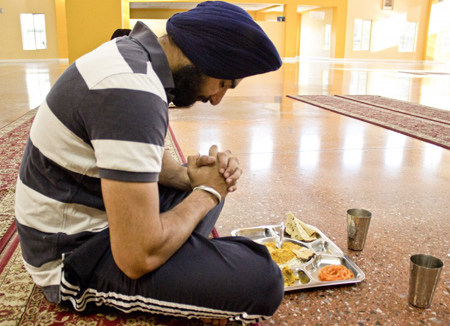 Kara - a plain steel bracelet worn around the right wrist. The steel denotes spiritual courage, and the circle is to remind the wearer of the unity, infinity and proximity of the Divine.
Kara - a plain steel bracelet worn around the right wrist. The steel denotes spiritual courage, and the circle is to remind the wearer of the unity, infinity and proximity of the Divine. -
 Kacchera - short white cotton breeches fastened by a draw-string, to denote chastity and moral restraint.
Kacchera - short white cotton breeches fastened by a draw-string, to denote chastity and moral restraint.
Lifestyle
Sikhs strive for devotion and remembrance of God at all times, truthful living, the equality of mankind, and renounce superstitions and blind rituals. Sikhism is open to all through the teachings of its 10 Gurus enshrined in the Sikh Holy Book and the Living Guru, Sri Guru Granth Sahib.
Sikhs try to observe the following guidelines :
- There is only one God – Waheguru
- Worship and pray to Waheguru alone, and remember Waheguru at all times
- Put your faith in the Guru Granth Sahib
- Remember that men and women are equal in the eyes of Waheguru
- The whole human race is one - distinctions of caste, color and class are wrong
- Idols, magic, omens, fasts, marks on the face and sacred threads are banned
- Dress simply and modestly
- Sikh women should not wear the veil
- Neither women nor men should make holes in their ears and noses
- Always work hard, and share with others
- Live a truthful life
- Avoid lust, anger, greed, attachment to worldly things and arrogance
- Live a married life
- Live a humble and simple life
The Sikh Religion was founded by Guru Nanak (1469-1539) in the Punjab (north-west India)
In 1539 Guru Nanak appointed Guru Angad as his successor, and entrusted the hymns that he had composed into his care - this was the start of the Sikh sacred text, the book which became the Guru Granth Sahib.
In 1539 Guru Angad (1594-1552) became Guru. He opened many new schools.
In 1552 Guru Amar Das (1479-1574) became Guru. He ordered Guru Ram Das, to construct a tank of "nectar" as a place of worship for the Sikhs
In 1574 Guru Ram Das (1534-1581) became Guru. He wrote many hymns which were incorporated into the Guru Granth Sahib. He built the town of Amritsar and the holy lake as Guru Amar Das had commanded. He married the daughter of Guru Amar Das, and appointed his youngest sn as the next Guru.
In 1577 the construction of the town of Amritsar and the holy lake (Sarovar) was completed.
In 1581 Guru Arjan (1563-1606) became Guru. He was the youngest son of Guru Ram Das and the grandson (through his mother) of Guru Amar Das. He designed and built the Golden Temple in Amritsar, and compiled the Adi Granth (the collection of Sikh sacred writings up to that date) and put it in the Golden Temple. One of the Moslem emperors had him tortured and executed. He was the first Sikh martyr.
In 1588 the cornerstone of the Golden Temple in Amritsar was laid, and the building was finished in 1604
In 1604 Guru Arjan, the Fifth Guru, collected and compiled the Sikh scriptures, along with writings from Hindu and Moslem holy men, into the Sikh holy book, the Adi Granth, which later came to be known as the Guru Granth Sahib. The book, written in his own hand, is still in existence, and is kept in the Golden Temple.
One of the Muslim emperors tried to force him to convert to Islam. He refused, and was tortured to death.
In 1606 Guru Har Gobind (1595-1644) became Guru. He was the son of Guru Arjan, and as a result of his father's death at the hands of the Muslim rulers he encouraged Sikhs to take up arms and resist the persecution.
In 1644 Guru Har Rabi (1630-1661) became Guru at the age of 14.
In 1661 Guru Har Krishnan (1656-1664) became Guru at the age of 5. He died at the age of 8 from smallpox which he contracted when healing people during a smallpox epidemic.
In 1665 Guru Tegh Bahadur (1621-1675), became Guru. He was tortured and executed by one of the Moslem emperors.
In 1675 Guru Gobind Singh (1666-1708), became Guru at the age of 9. He was the son of Guru Teg Bahadur, and the last Guru in human form, and founded the Khalsa in 1699. He added some of Guru Tegh Bahadur's hymns to the Adi Granth, and renamed it the Guru Granth Sahib. He died after an assassination attempt instigated by a Moslem governor. His four young sons had already been killed in earlier battles.
In 1699 Guru Gobind Singh created the Khalsa
In 1708 Guru Gobind Singh ended the line of human gurus by declaring the Granth to be a living guru, known thereafter as the Guru Granth Sahib
In 1799, Ranjit Singh, the nineteen-year-old leader of a Khalsa band, seized power in the city of Lahore and established a Sikh Empire. He was crowned Maharaja in 1801 and became known as the Lion of the Punjab. Ranjit Singh ruled for forty years and created a strong Sikh army. He wore the world’s largest diamond (the Kohinoor) on his right arm. He had the upper walls of the Harimandar Sahib covered with gold, giving it its distinctive appearance and its English name. However, the Sikh Empire only lasted for a few years after Ranjit Singh died.
In 1849 the British annexed the Punjab. Ranjit Singh's widow, who was acting as regent for his young son was imprisoned by the British, and his son Dalip converted to Christianity and was exiled to England, where he died in 1893. The Maharaja’s diamond was cut down to fit Queen Victoria’s crown, and is still part of the British Crown Jewels.
In 1897 the first Sikhs came to northern America, to work as farmers, laborers, and on the construction of the Canadian Pacific Railway. Familnes in the Punjab were an added incentive to emigration.
In 1909 the first Sikh Gurdwara in North America was built in Vancouver.
 1914-1918 - WW I - Sikh regiments came to Europe to join in the battle against the German Kaiser
1914-1918 - WW I - Sikh regiments came to Europe to join in the battle against the German Kaiser
In 1919, about 10,000 - 20,000 Indians (Hindus, Moslems, Sikhs, including many women, children, and old people) were holding a protest meeting in a garden by the Golden Temple. The British General E. H. Dyer ordered his troops to fire on the demonstration, killing about 400 and injuring 1,200 people who were left without medical help. This came to be known as the Jallianwallah Massacre after the name of the garden.
General Dyer was forced to retire, and the army was re-structured and given training on how to handle crowds.
In 1920 the Sikhs formed the Sikh Ahromani Gurdwara Prabhandak Committee (SGPC) to carry out reforms and to manage the various Sikh shrines in India. Over the years various Hindu images and practices had crept into Sikhism, so these were cleaned out. The SGPC consists of elected Sikh representatives, and continues to administer the Sikh shrines, schools, colleges, farms, and free kitchens in India, and forms a liaison with the Indian government.
In 1947 India gained independence from British rule. However, there were tensions between the Hindu and the Moslem communities, and the Sikhs were caught in the middle of the conflict. The Sikhs had wanted the land to stay united, with a mixed religious population, but the Hindus and the Moslems engaged in a bloody war which killed thousands and devastated the land. The Moslems wanted, and eventually were granted, their own region(s) which became Pakistan. The Hindu regions became what is now the country of "India" and includes the Punjab where most Sikhs live.
In 1948 The British government passed the British Nationality Act, which gave the citizens of former British colonies the right to settle in Britain. Thousands of Sikhs left the strife between India and Pakistan to emigrate to Britain where they formed a large labor force after WWII.
In 1984, following several years of fighting and murders around the Golden Temple, Prime Minister Indira Ghandi ordered "Operation Blue Star" - a military attack on the Golden Temple to oust one of the leaders of the fighting. Hundreds of civilians were killed, Sikh soldiers in the Indian army mutinied, and eventually Indira Ghandi was assassinated by two Sikh soldiers who were her bodyguards. This led to anti-Sikh riots in which 3,000 Sikhs were killed.
On August 5, 2012, a white supremacist fanatic invaded the Gurdwara of a Sikh community in Oak Creek, Milwaukee, and shot the worshippers just because they were "mud colored"
Copyright © 2015 Shirley J. Rollinson, all Rights Reserved